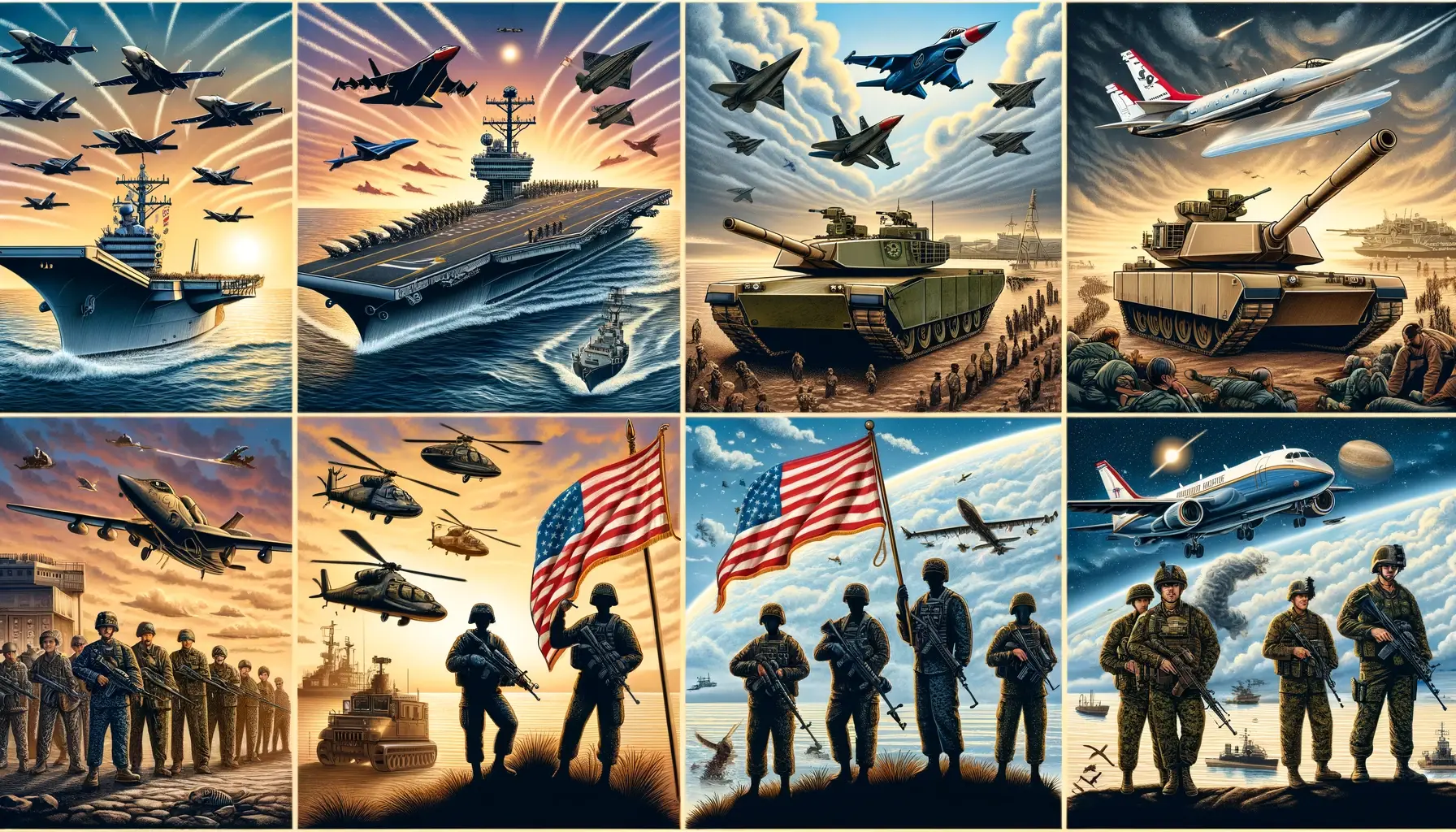The US military is a strong and secure pillar, not just for the nation, but also on the global stage.
From the silent depths of the oceans to the boundless frontiers of outer space, the different branches of the U.S. Military work in a symphony of strategic prowess and tactical expertise.
This article discusses the roles and responsibilities of each branch and how they work together to protect the country. Understanding the different abilities and roles of these branches is important not only for military personnel but also reflects the country’s commitment to peace and stability in a rapidly changing world.
- Army: The largest and oldest branch of the U.S. military, responsible for land-based military operations.
- Navy: Specializes in naval and amphibious warfare, including the operation of naval ships and submarines.
- Air Force: Conducts aerial warfare, air defense, and space warfare missions. It also provides air support to ground and naval forces.
- Marine Corps: A component of the Department of the Navy, it is specialized in amphibious warfare and also provides rapid-response capabilities.
- Coast Guard: Operates under the Department of Homeland Security in peacetime but can be transferred to the Department of the Navy by the President or Congress during wartime or when directed. It is responsible for maritime law enforcement, search and rescue, and maritime defense.
- Space Force: Established as the newest branch of the U.S. military, responsible for space warfare and operations.
Each of these branches serves a unique role in the defense and security operations of the United States, with distinct traditions, missions, and areas of expertise.

What is the difference between army and navy, Marine corps, Air Force and Coast guards.
Army:
- Primary Mission: The Army is primarily responsible for land-based military operations. It is the main ground force of a nation and is tasked with protecting the country from terrestrial threats, maintaining a presence at borders, and securing occupied territories.
- Personnel: The Army is made up of soldiers who are trained in various combat and support roles, including infantry, armor (tanks), artillery, special forces, engineering, and logistics.
- Equipment: The Army deploys a wide range of equipment, including tanks, helicopters, heavy artillery, drones, and all types of land vehicles and weaponry.
- Operations: Army operations can range from ground combat to peacekeeping missions, counterinsurgency, and humanitarian aid.
Navy:
- Primary Mission: The Navy’s primary focus is on naval and maritime operations. Its responsibilities include securing a nation’s waterways, ensuring the freedom of navigation, projecting power overseas, and providing a deterrent presence in international waters.
- Personnel: The Navy consists of sailors who serve on various types of ships and submarines, and also includes naval aviators who operate aircraft from carriers.
- Equipment: The Navy’s arsenal includes aircraft carriers, submarines, destroyers, frigates, amphibious assault ships, and various support vessels, as well as naval aircraft.
- Operations: Navy operations include sea control, power projection, deterrence, maritime security, and all aspects of warfare at sea. It also provides critical support for land and air forces during joint operations.
Marine Corps:
- Primary Role: The Marine Corps specializes in amphibious operations. Their primary mission is to be the rapid reaction force, capable of responding quickly to crises and projecting power from sea to land.
- Size and Scope: The Marines are typically smaller and more agile than the Army. They are trained to be self-sufficient, with units often deploying with all the resources needed for their mission.
- Occupational Specialties: While they also have a variety of combat and support roles, the focus is on infantry, reconnaissance, and assault amphibian units, with a higher ratio of combat troops to support troops.
- Equipment: The Marines use a mix of equipment that can be rapidly deployed, including lighter armor, amphibious assault vehicles, and vertical take-off and landing (VTOL) aircraft.
- Bases and Deployment: Marine units are often deployed on naval ships ready for expeditionary missions. They are trained to establish forward-operating bases and to be able to deploy quickly without the need for established facilities.
Coast Guard:
- Primary Role: The Coast Guard is responsible for maritime safety, security, and environmental stewardship in coastal waters and on the high seas.
- Peacetime Operations: Unlike the Army, the Coast Guard’s peacetime duties include search and rescue, maritime law enforcement, aids to navigation, immigration control, and environmental protection.
- Military Function: During wartime or under presidential orders, the Coast Guard can be transferred to the Department of the Navy and take on more traditional naval roles, such as securing ports and littoral regions, and protecting shipping lanes.
- Assets: The Coast Guard operates cutters, boats, and aircraft that are typically smaller and more versatile than Navy ships, designed for a wide range of missions close to shore.
- Personnel: Coast Guard members, known as Coast Guardsmen, are trained for both military and law enforcement functions, which can include direct action, boarding and inspecting vessels, and emergency response.
In conclusion, the U.S. Military’s branches each serve a critical role in the defense and security of the nation. Together, they form an impenetrable shield, safeguarding the values and people of the United States against all adversities. The missions of these organizations are diverse, matching the domains they safeguard. This guarantees that America’s defense strategy keeps up with emerging threats. With the advent of the U.S. Space Force, the military continues to expand its horizon, proving that it remains vigilant and forward-thinking. Understanding the different roles of the Army, Navy, Air Force, Marine Corps, Coast Guard, and Space Force helps us appreciate those who serve and the challenges of maintaining security in the 21st century.
